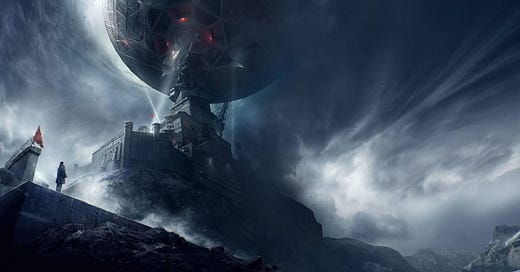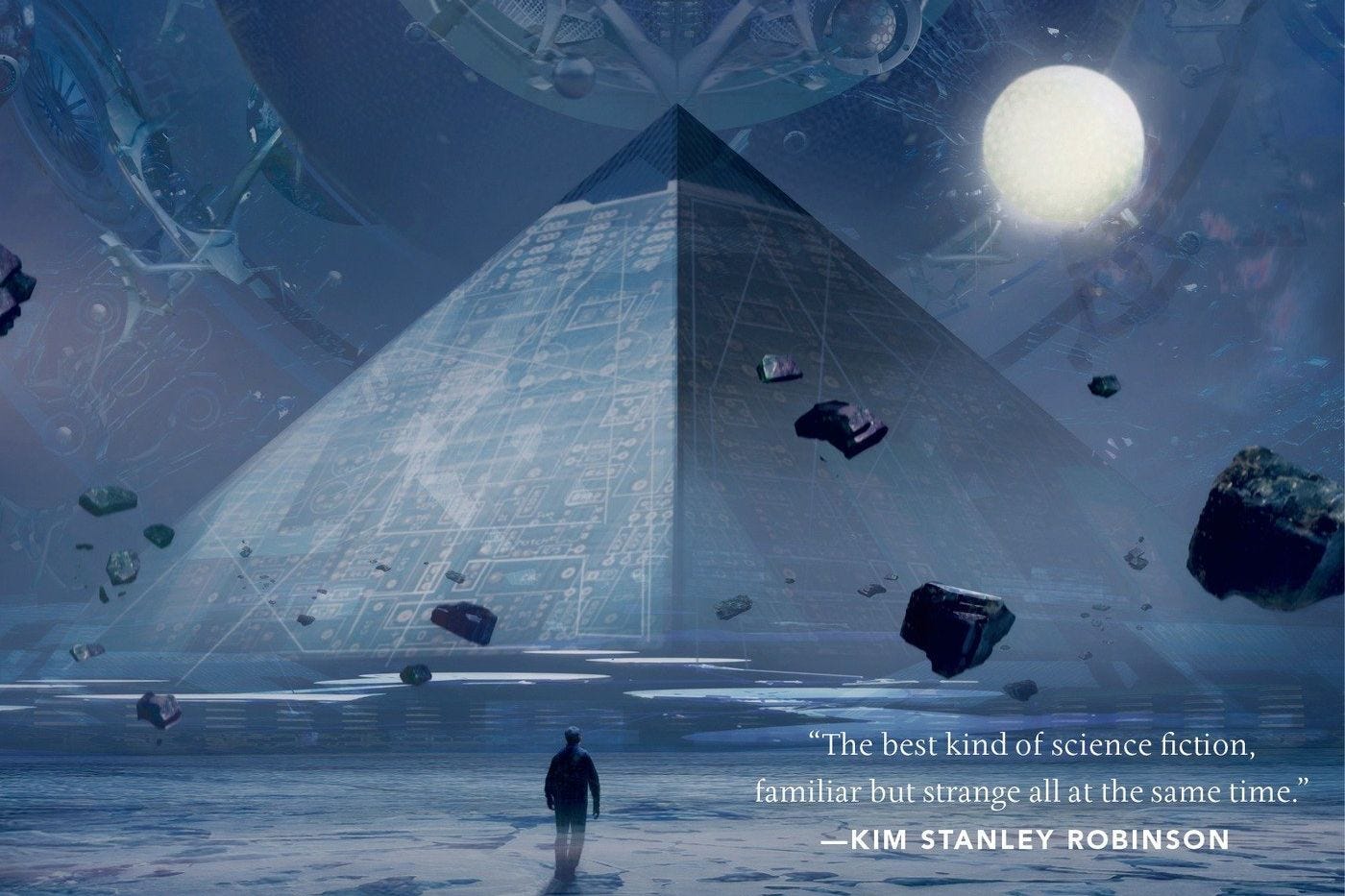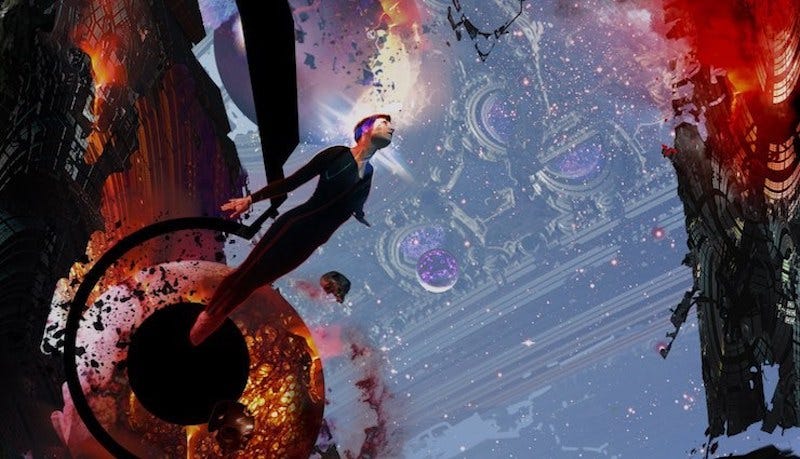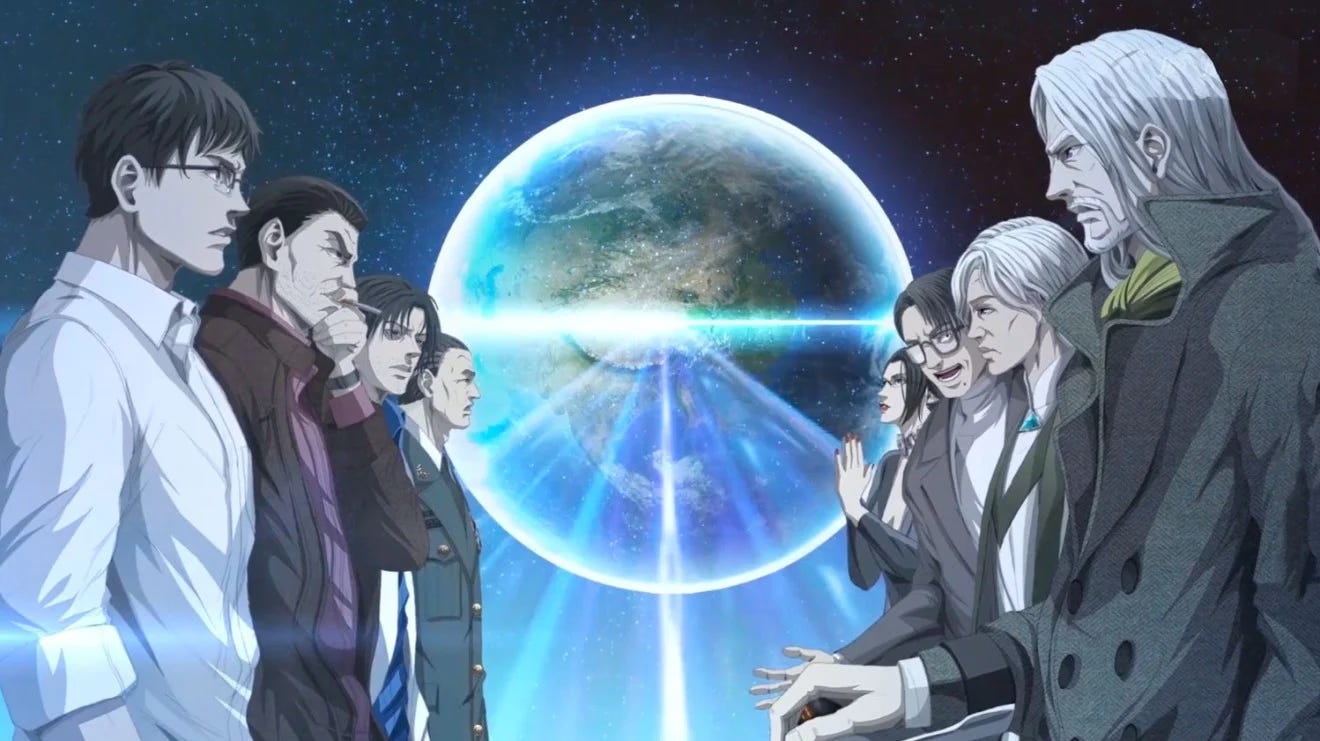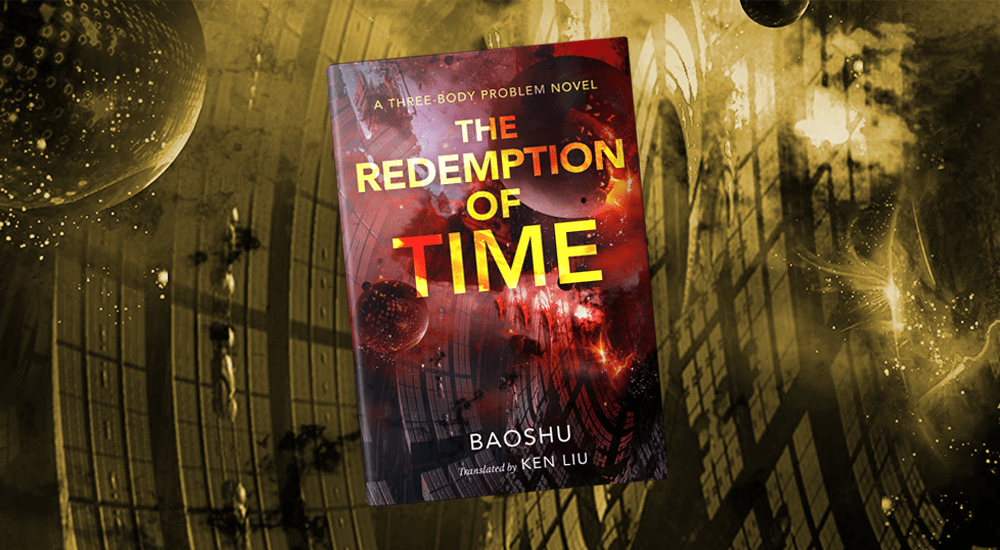[Book Review] Remembrance of Earths Past
The 3 Body Problem, a 21st century Asimovian science fiction horror
Remembrance of Earths Past is a trilogy by Liu CiXin published in 2008 and translated to English in 2014. The trilogy begins with the book The Three Body Problem. Contained is a discussion of human nature, the nature of the universe, and the way human history and life, are a never-ending series of cycles thrust ever onwards to some ultimate incomprehensible end. It honestly took me well over a year to get to reviewing this piece, and it’s one of the most difficult reviews I’ve written. I read this trilogy some time ago, but the imagery is so vivid and the material so thought-provoking that I elected to take my time before making final judgements.
This trilogy is difficult to discuss without significant spoilers as the first book is almost a preface to the following two, and the second book is almost a preface to the third. The structure of the individual novels varies considerably. The first novel reads like a lengthy vignette while the second and third read like multiple intertwining epics. As each book concludes, the world-building expands by an order of magnitude. Book one takes place in a 21st century civilization, book two expands to a Kardashev-1 civilization and book three explores both distant space and deep time. The trilogy exists at the scale of individuals and vast meta-civilizations alike.
I will be reviewing each book in the series individually below. With the understanding that the book 2 review will contain spoilers for book 1 and the book 3 review will contain limited spoilers for book 2.
In all seriousness; if you’ve any interest, please read the books before diving into the spoilers. This trilogy has some of the most fascinating and terrifying twists and turns of any novels I have ever read… To the point that some terminology in modern scientific cosmology has since been named after ideas first discussed in the text of this trilogy.
Preface: Remembrance of Earths Past
The entire trilogy of books is among the most fascinating I’ve ever read. I’ve heard them compared to Isaac Asimov’s Foundation series, which is apt. Within is some of the most thought-provoking literature of the twenty first century. In this reviewers opinion, the trilogy is equivalent to Asimov’s work in creativity, complexity, philosophy, and science.
There are so many themes and points of complex discussion in the trilogy that it will likely be studied like the work of Tolkien for generations to come. In terms of comparison, it is a combination of the wonders of Arthur C Clark, and the millennia-spanning civilizations of Isaac Asimov. Simultaneously it is as down-to-earth as any war documentary. The translation from Mandarin to English is incredibly accurate. Some readers state that characters feel wooden to many English readers, that isn’t a translation error; That’s just how Chinese culture was in the 2000s when the book was written.
The trilogy balances the future-history of our species on the edge of a knife. Faced with incomprehensible threats from without, and our own failings as cultures and peoples within. The trilogy asks readers consider our ultimate place in the universe at a pan-galactic scale. CiXin Liu carefully and slowly develops these vast philosophical ideas through realistic sociology and science, along side fantastical awe inspiring horrors and vistas of a fundamentally alien cosmos.
The Three Body Problem
The Three Body Problem begins during the cultural revolution in China from the perspective of a girl named Ye WenJie. The cultural revolution is among the most extreme instances of puritanical communist bloodletting in human history. This section of the initial book provides a unique and comprehensive look into the mindset of left wing zealots, and a background to the actions of the (arguably) most pivotal character of the entire trilogy. To follow the rest of the trilogy; taking place several generations after the Cultural Revolution, one must understand the revolutionaries. The reader learns the lengths to which the revolutionaries will go and their total inability to comprehend a defiant reality. It is a terrifyingly accurate understanding of the psychology of the progressive.
Ye WenJie, due to her fathers anti-revolutionary ideals, is treated as a reactionary and, despite her skills as a physicist, ends up working as slave-labor in forest removal. After months of hardship she is moved to a facility called Red Cliff. That facility has been trusted by the Chinese government to perform an ultimate secret mission: discover and communicate with alien life.
The accuracy with which political zealots were written helped me understand the Left in the 21st century West. The first few chapters are properly motivating.
After the introduction to the cultural revolution through the eyes of Ye Wenjie, the story shifts to a 21st century perspective through the eyes of an engineer named Wang Miao. The two stories provide an in-depth understanding of character motivations. An understanding critical to comprehend the books conclusion. Wangs story begins with a slew of suicides among experimental physicists with no one really understanding why. Ye WenJie’s daughter, a physicist named Lao Dong is among those dead. The suicides seem to originate in quantum research. At the bottom of quantum mechanics, they have found something.
Miao Wang begins experiencing events that are either unlikely or impossible after a number of high complexity conversations, the importance of which are slowly revealed in the text. He eventually gets looped into a virtual-reality game that is supposedly designed to teach humanity about a distant civilization. Beneath the deaths and impossible events lies some organization with a vast reach and resources. This conspiracy builds to a head and Miao Wang is forced to join forces with a police investigator named Shi Qiang (Da Shi). Da Shi as a fantastic character who makes it his mission, as a part of an anti-terrorist unit, to uncover what’s at the bottom of the conspiracy.
It should be noted that in the Netflix adaptation of the 3 Body Problem, Da Shi is the most honestly adapted of the characters. I did not really like the adaptation, but the character of Da Shi was rendered impeccably. Just read the book, the television show is hardly worth your time.
Eventually the truth will come out, secrets will be revealed, and all of humanity will find out that there is something out there that has, for its own reasons, declared war upon our sciences, peoples, and cultures. This book is about revenge, who gets caught in the crossfire, idealism, ivory towers and dark conspiracies. Ultimately, The Three Body Problem is about our species realizing it is time to grow up, and finding little space for the self-interest of an outdated generation.
The Dark Forest
(Spoiler Warning for book 1)
The first book revealed that there exists a terrifyingly advanced alien race that wants our world, why ours and not some other is yet unknown. These invaders are only four lightyears distant, and their invasion fleet has already begun flight. Utilizing highly advanced quantum technologies, the hostile beings of Tri-Solaris can accurately observe all actions on earth. Their invasion fleet travels at 1% of the speed of light, and will be here in four centuries. Dark Forest picks up with the global scramble to create some system by which we might defend our world and species.
The Dark Forest primarily centers around a character named Luo Ji who, by happenstance, once had a conversation with Ye WenJie before the first book took place. During the scramble for planetary defense the United Nations organizes to form a number of technological initiatives and strategic meetings. It is understood that the hostile alien forces have the ability to monitor nearly all actions taking place on earth. Hence the United Nations develop the Wall-Facer Program.
The Wall-Facer Program is predicated on two key facts.
1] While all of humanity could be monitored by the Tri-Solarans, the Human Mind was as yet inscrutable. For all their technology, the enemy could not monitor human thoughts.
2] The invaders of Tri-Solaris did not not understand the human capacity to lie. They cannot themselves lie, and only recently came to understand that we can, and what that means.
Thus the Wall-Facer Program was created. Named after those who would seek enlightenment through meditation while staring at a blank wall. A number of experts were selected to develop plans of action for securing the human race, and implement those plans. The individual Wall-Facers would work alone and never reveal their ultimate intentions. Their plans must be implemented in such a way that an outsider looking in will not understand the ultimate goal until it has been completed. In this way, humanity would be able to act covertly, even while fully monitored by Tri-Solaris. A challenge for any one.
Brilliant minds, leaders, engineers, and philosophers were selected. Along with them was Luo Ji, a substitute teacher for physics from a no-name university in rural china. Why he was selected aside far more distinguished peers no one knew. Not even those who had selected Luo Ji knew. He wasn’t selected to be a wall-facer because of some personal connection, nor had he accomplished great feats, or shown implacable will. Rather he was selected because the Tri-Solaris leaders of the future invasion desperately wanted him dead, and no one knew why. Not even Luo Ji understood the origin of his selection until far, far later.
The Dark Forest takes place over the course of several hundred years of human history. Those selected for the Wall-Facer program are given incredible power and resources, commanding billions of dollars with no questions asked as to their ultimate aims and no oversight. Once their plans are set into motion, the Wall-Facers go into suspended animation, a deep-freeze. By freezing themselves, Wall-Facers jump through time like mythical figures, every few decades reappearing to review the progress of their plans and make further adjustments.
The book hinges on questions about human nature, questions about the nature of life in the universe, and questions about duty, morality, and game theory. In many ways this book develops these questions in a way no previous author ever has.
Eventually, the vanguard of the alien invaders does arrive in the solar system. A single probe of incredible technological power. While humanity has had hundreds of years to prepare, the distant invaders have prevented our civilization from unlocking sub-quantum technology. As such humanity is still, though far more advanced in both culture and engineering, no more advanced in terms of physics and cosmology than at the dawn of the 21st century. Humanity is vastly surpassed by a technologically superior opponent. Yet the central theme of the book is not about technology, but morality and duty. It is about whether Luo Ji can unlock a critical secret to the nature of life in the universe… and whether or not he has the fortitude to apply it.
Deaths End
(Spoiler Warning for Book 2)
The book begins, critically, with a seemingly disconnected short that takes place in Constantinople, when it fell in 1453. A pivotal piece of a puzzle that is not revealed until far later in the text.
Death’s End is the longest book in the trilogy and weaves a narrative in parallel with the story of the second book. It begins, like the second book, with the dawning realization that a technologically superior alien intelligence seeks to take for itself our world. Death’s End follows the story of a woman named Chang Xin. Chang Xin was a astro-engineer who was hired to partake in one of several emergency programs begun when the horror of the upcoming Tri-Solaris invasion was revealed. Chang Xin works for an organization that hopes to send a spy to the Tri-Solaris invasion fleet; relying on alien technology, curiosity, and strategic interest to recover whatever is flung at them. Chang Xin and those she works with haphazardly hurl a perfectly preserved frozen human brain at the Tri-Solarin fleet. The thought is that the invasion fleet will retrieve and study the brain, and that the individual cast into the void will then find some way of contacting humanity once again.
Much like the Wall-Facer program, the characters of Death’s End leap forward in time. They engage in diplomacy, and Chang Xin eventually finds herself hundreds of years in the future in a very different culture. When humanity first discovered that an invasion was inevitable, we responded with radical ideas. The resultant terror and negligence nearly destroyed our own civilization. For nearly three generations, humanity entered a dark age, later to regain its footing with strong humanitarian and egalitarian ideals. The population has shrunk, but our technology was powerful than ever before.
We had fleets of starships, we had colonies throughout the solar system, but still the invasion of Tri-Solaris came closer. It wasn’t until Luo Ji was reawakened, and revealed the secret of the Dark Forest to humanity that an era of safety and prosperity truly began; the deterrence era. In this era of peace, is where Chang Xin returns from a long sleep, and reassesses the humanity that has grown in this period of complacent peace.
The decisions of Chang Xin define the following two centuries of humanity. An election is eventually held to replace the legendary sword-holder Luo Ji, and Chang Xin, being from his era, must decide if she is able take on a role of such critical importance. Whether she is capable of prolonging the delicate balance of deterrence, or whether empathy and idealism will render her impotent.
The book stretches into deep time, as humanity advances to build complex technologies and discover terrible secrets about the universe. At the beginning of the book a climatologist suggests that without life to regulate earths environment, it would have been an inhospitable desert millions of years ago. Ultimately the question of what effect life has its environment is expanded to a far larger scope than just our one world. By incredible skill and luck, some secrets are relayed by Chang Xin’s spy, others we have to learn ourselves the hard way. The book concludes many lightyears from Earth, and many thousands, or possibly millions, of years in the future.
Death’s End poses some of the most complex questions about human culture, masculinity, femininity, and ego that have been posed in any such book. The author fundamentally understands the balance between empathy and self interest that must be struck on behalf of survival. The book highlights successes and failures in the human spirit. What degree of mercy can be afforded in the face of a hostile universe, what degree of utilitarianism is required. What, ultimately is the cost that will be paid if we stray too far from reality on behalf of idealism. Is humanity truly prepared to face the horrors of the universe? Even after hundreds of years of technical and social development… after thousands of years. Can we face those horrors, survive them, and remain human?
Conclusions
The Remembrance of the Earths Past trilogy is potentially some of the best science fiction ever written, possibly the best. It has the political honesty of a Strugatsky novel, the innovation of a Asimov novel, and the complexity of Frank Herbert. Like Dune, I expect this trilogy to be nearly impossible to put to film for a long time. At least until the ideas have sufficiently percolated into the culture that they do not need to be explained during the run-time.
The questions it asks of the audience, the speculative solutions it provides, are extremely high-minded. The trilogy was published in 2007, translated to English in 2014. It is only now, over 10 years after entering circulation, that the book has attained the legendary status it deserves. The delay is because the series was too ahead of its time in 2007. Some of the ideas discussed in the trilogy, particularly in Death’s End, have been disturbingly close to prophetic. Some of the ideas discussed in Dark Forest have now entered common parlance among cosmologists.
While high-minded and brilliantly written, the trilogy does not use needlessly complex language. It is not linguistically opaque like a novel by Alastair Reynolds. The inaccessibility is completely down to the ideas; ideas that are so powerful many have a hard time wrapping their heads around them. This trilogy predicted some of the issues with gender dynamics we are now experiencing in the West in the 2020s. The trilogy also clearly portrays the difference between empathy and complacency, with an emphasis on how one is often misconstrued as the other.
Importantly, the series does an excellent job of developing a civilization without losing track of the individuals making up that civilization. While many of the characters feel wooden in dialogue, the emotive power of their actions provides more meaningful insight. Reading into a characters motivations, background, hopes, and dreams is an important part of this trilogy. The Remembrance of Earth’s Past is about more than the survival of the human species, it is a discussion about what makes us human. It is a discussion about what technologies enhance our humanity, what technologies inhibit our humanity, and whether we can ultimately, afford to keep it.
Death’s End is the only book I’ve ever read that’s given me nightmares. I’d highly recommend this series to any one able to contemplate the vast unseen vistas of the universe written within.
I would honestly recommend reading the trilogy twice, the second reading after some number of years when one has had time to properly contemplate the ideas.
Redemption of Time
While Liu CiXin has officially canonized the Redemption of Time, this book is an unofficial fourth entry to the trilogy. Redemption of Time began as fan-fiction by a skilled author. The book takes place after the conclusion of Death’s End. While the book is well written and helps to complete some of the more vague loose ends in Death’s End, it does not meaningfully expand on Liu CiXin’s ideas. While it is by no means an unenjoyable read, it is intellectually “smaller” than the work of Liu CiXin.
Redemption of time is a book for those who have completed the trilogy and wish to continue exploring the universe created in the Remembrance of Earth’s Past Trilogy. The narrative of the book reaches from the very beginning of the series all the way to the edges of space and time.
Personally, I consider it to be mostly non-cannon as the proposed ideas are not fully developed. It is fun to read as a possible future-history to the trilogy, but I feel that the original author could have done better had he felt another entry was needed. I feel that, ultimately, the trilogy ended where it was supposed to end. Still, I respect the work of BaoShu and this attempt at continuing the story.
While I would love to further explore the universe proposed by the Remembrance of Earth’s Past trilogy, there are virtually no authors with sufficient imagination, technical skill, and authorial aptitude, to truly expand on it. Upon completing the trilogy, feel free to read Redemption of Time, but understand that it cannot take one to the intellectual peaks, or emotive valleys of the first three books.
I will consider writing further on this trilogy as content behind a pay-wall. I would prefer to avoid spoilers for future readers as much as possible. Simultaneously, I desperately want to discuss some of the nuances of the trilogy with others who have read it.

